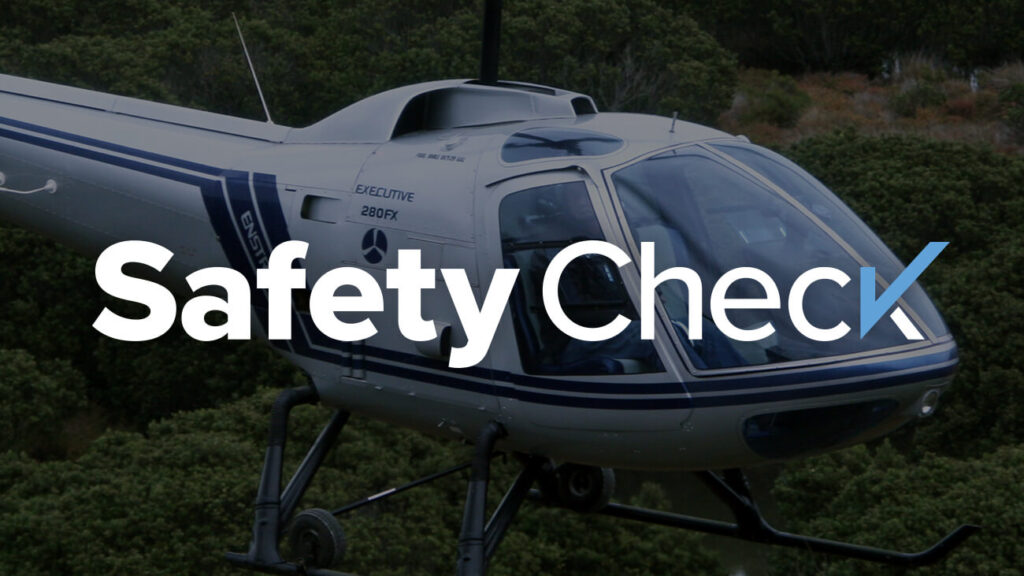Safety Check: Stayin’ Alive with Precautionary Landings

84 years ago, in September of 1939, Igor Sikorsky lifted off in a VS-300, the world’s first practical helicopter, for an entire ten seconds in Stratford, Connecticut. Since then, helicopter manufacturers, like Enstrom Helicopter Corporation, have invested in new technology to make rotorcraft safer. However, no helicopter is 100% crash-proof.
Former HAI president, the late Matt Zuccaro, led two very successful safety campaigns during his tenure; “land and live,” and his personal favorite, “just land the damn helicopter!” I remember the passion he would bring to a welcoming breakfast at an HAI convention, zealously reminding flight crews to make use of the biggest strength of vertical flight, the ability to land a helicopter virtually anywhere! He would argue that, in a high percentage of crashes, landing at the first sign of trouble could have broken the chain of events leading up to the crash.
In November 2015, I was flying with a good friend in his EC120B when we heard a faint noise, almost like an avionics fan, coming from the rear of the aircraft. We decided to make a precautionary landing. A precautionary landing might be necessary if you notice mechanical issues, the weather is deteriorating rapidly, fuel is running low, or the pilot becomes suddenly ill.
During our landing approach, the noise only intensified and seemed to correlate with engine speed. At fifteen feet above the ground and twenty-five knots indicated airspeed, the helicopter began an uncommanded left yaw. We tried to use a corresponding right pedal input, but it was ineffective, and soon we found ourselves spinning violently out of control.
I immediately reduced the engine power and initiated a hovering autorotation. Fortunately, we were able to land without damaging the aircraft. An NTSB inspector later told us we were the first to ever experience a complete loss of tail rotor thrust on the EC120B. The inspector blamed metal fatigue between the air conditioner compressor drive pulley and the main gear box tail rotor. The FAA issued an emergency airworthiness directive within days.
Our decision to make a precautionary landing likely saved our lives. So why isn’t this more pilots’ first resort?
I learned the answer to that question several years ago during a Part 135 observation flight. The Principal Operations Inspector explained that, during his many years as an FAA accident inspector, most of the time, the pilot involved in the crash knew there was a problem yet continued the flight. Often, the pilot later admitted they were afraid of facing repercussions from their employer for causing a delay. Others said they were afraid of creating a public spectacle, with the possibility of journalists and local police swarming their helicopter.
The inspector’s position was clear, if a pilot judged a precautionary landing was necessary for safety, he would personally defend the pilot’s decision to the highest level. I can’t speak for every FAA inspector, but I would assert most would agree a safe, premature landing is better than an unsafe landing or crash.
To the instructors who are reading this, please teach your students to take advice from the Bee Gees and learn the importance of “stayin’ alive.” And, as Matt Zuccaro would say, “just land the damn helicopter!”
Fly safe.

Randy is a dual rated Airline Transport Pilot with 13,000 flight hours in airplanes and helicopters. He has type ratings in the BE400 and CE500. Randy has been a rotorcraft Designated Pilot Examiner representing the Grand Rapids FSDO since 2014. Currently he works for Sweet Helicopters, a northern Indiana Part 135 air carrier operator and serves as the Airport Manager of the Goshen Municipal Airport.
About Enstrom Helicopter
From Rudy Enstrom’s early designs in 1943 to initial testing in a Michigan Quarry in 1957 to aircraft operating on six continents, Enstrom Helicopter Corporation has maintained a reputation for safety, value and performance. Based in Menominee, Michigan and proudly made in the United States, Enstrom has a rich history for design innovation. The goal is to provide helicopters to the customer’s exact specification and deliver support and maintenance worldwide.